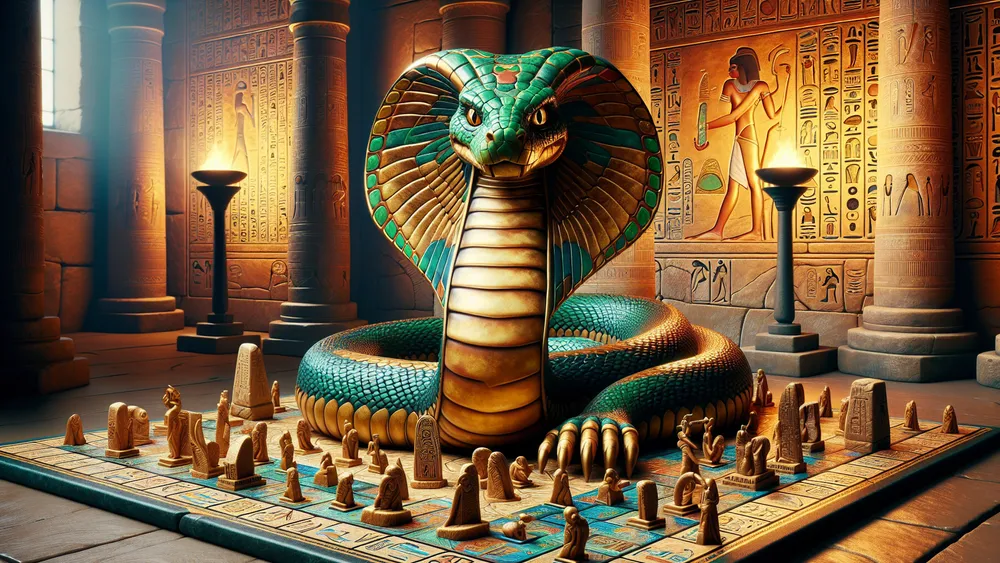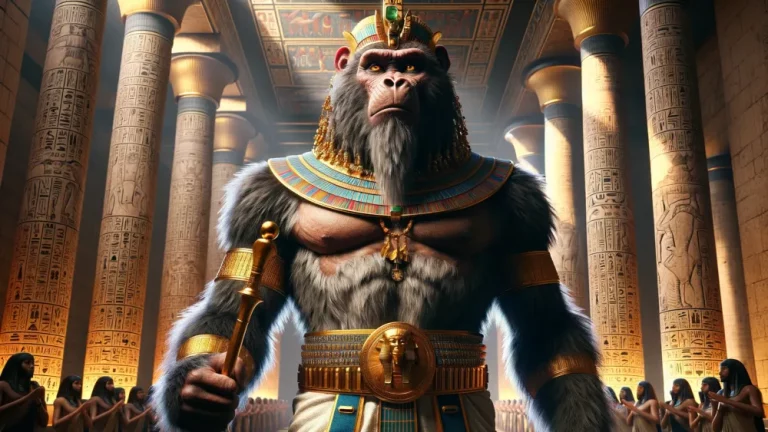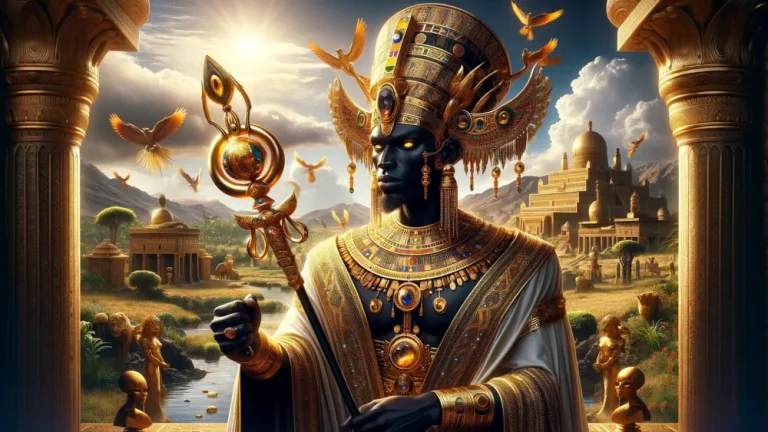Mehen: Egyptian Snake God and Board Game In Mythology
Welcome to a look into Mehen, a strange person in old Egyptian stories who mixes the worlds of god and game. If you aren’t familiar with stories about gods, imagine Mehen as both a guard and a sign of keeping safe, like a shield in tales of knights and big lizards.
Key Points:
- Mehen is an ancient Egyptian snake god and board game.
- Mehen guards the sun god Ra in the underworld and assists Osiris.
- Mehen is symbolized by a coiled snake and nine rings, representing protection and cyclical time.
- Mehen was honored during the Middle Kingdom with rituals and ceremonies.
- The ancient game of Mehen reflected the deity’s protective attributes and the cyclical nature of life.
- There is debate on whether the game of Mehen influenced the god or vice versa.
- Mehen’s roles were crucial in ancient Egyptian mythology, emphasizing protection and order in the cosmos.
In this writing, we will look at the two sides of Mehen, starting with him as a snake god guarding the sun god Ra when he moves through the dangerous underworld at night. Next, let’s see how Mehen’s job includes the underworld, where he helps Osiris and leads souls.
We will also find the meanings behind Mehen looking like a twisting snake and his nine rings. As this writing moves through old writings and objects, you will see how Mehen was honored and remembered, mostly in the Middle Kingdom. At the end, we will link Mehen the god and Mehen the board game, checking their important past and the curious argument about which came first.
So, let’s start this myth story and find the many parts of Mehen’s history.
Mehen: Overview and Key Facts
| Key Point | Description |
|---|---|
| Name | Mehen |
| Role | Guard god, helper of Ra, and sign of safe-keeping in the world of the dead. |
| Depiction | Often shown as big curling snake, sometimes around the sun boat. |
| Symbolism | Means safety, repeat of time, and trip in the world of the dead. |
| Mythological Texts | Named in many old Egypt writings, like Pyramid Texts, Coffin Texts, and Book of the Dead. |
| Primary Function | Guarding Ra in his night trip in the world of the dead and helping Osiris in the next life. |
| Cultural Significance | Was especially honored during Middle Kingdom, with rituals and ceremonies for him. |
| Associated Artifacts | Seen in hieroglyphs, tomb pictures, and old items. |
| Board Game | Old Egypt board game named after Mehen, meaning the safety and repeat nature of the god. |
| Nine Rings | Often shown with nine round rings, meaning the levels of safety and repeat nature of time and the world. |
| Legacy | Mehen’s power shows in culture and games, showing he was important in old Egypt life. |
Mehen’s Job in Myths and Legends
Next, we have a basic idea of Mehen. Let’s dive further into his special tasks and duties inside old stories from Egypt.
Mehen Keeping Ra Safe
Think of Ra, the sun god, taking a dangerous nightly trip through the underworld, a place full of disorder and bad forces. During this risky travel, Mehen serves as Ra’s constant protector, like a guard keeping a person safe from harm. Mehen is often shown winding around the sun boat, which carries Ra, giving a barrier of safety against the underworld’s dangers.
This role appears in many old Egyptian writings: Pyramid Texts, Coffin Texts, and Book of the Dead. In these writings, they explain how Mehen’s being there makes sure Ra travels safely, letting the sun come up again every day, showing how order wins over disorder.
Mehen protects Ra during his dangerous nightly trip through the underworld, safeguardin the sun god from harm and allowing the sun to rise daily, symbolizing the victory of order over chaos.
Mehen’s Role Down Below
Think of the underworld as a big, dark place where souls go on their way to the next life. In this unknown area, Mehen works to keep Osiris, the god of the next life, safe and to help souls on their trip. He acts like someone showing people through a dark forest, making sure the trip is safe and in order.
Pyramid Texts, Coffin Texts, and Amduat are old writings that tell about Mehen’s protective job, wrapping around Osiris to keep him from danger and guiding souls to their final stop. These writings stress Mehen’s role in keeping order and giving safety in the disorderly underworld, making sure life, death, and rebirth go on without stopping.
The Sun Boat: Mehen Wrapping Around
Think of the solar barque as a big boat sailing through the dangerous waters of the underworld every night. This boat takes Ra, the sun god, on his nightly trip and faces constant threats from chaos and bad forces. Mehen, shown as a large coiling snake, wraps himself around the solar barque, working as a protective barrier similar to how a shield protects a warrior.

This protection act is very important for making sure Ra can move through the underworld safely and come up each morning, showing the win of order over chaos. The idea of the solar barque and Mehen’s protective job is explained in many old Egyptian writings, stressing the importance of this nightly trip in keeping cosmic balance.
| Key Aspect | Description |
|---|---|
| Solar Barque | The boat that carries Ra through the underworld each night. |
| Mehen’s Role | Coiling around the solar barque to keep Ra safe from chaos and bad forces. |
| Symbolism | Shows the win of order over chaos and the cycle of time. |
| Ancient Texts | Explained in writings such as the Pyramid Texts and the Book of the Dead. |
What Mehen Stands For and How He’s Shown
After looking at Mehen’s roles and tasks, it is time to see what he stands for and how he appears in old Egyptian stories.
Mehen, the Big Coiling Snake
Imagine a huge serpent, its body wrapping protectively around something important. This is how Mehen is shown in old Egyptian stories – as a giant snake that circles and keeps safe. The snake, in this scenario, stands for protection, eternity, and the cycle of time.
Much like a guard wrapping around a treasure to keep it safe, Mehen’s coiling body shows his job of shielding the sun god Ra during his nightly trip through the underworld. This picture is not just about physical protection. Also, it is about keeping cosmic order and balance, making sure that chaos stays away.
What the Nine Rings Mean
Picture the nine circles of Mehen as layers of protection or steps in a journey. In old Egyptian beliefs, these circles are not just for show; they have deep meanings. They stand for the different stages of Ra’s nightly trip through the underworld, each circle working as a shield against chaos and bad forces.
The nine circles also mean fullness and the cycle of time, showing Egyptians’ belief in the endless cycle of life, death, and coming back again. In old Egyptian art and writings, these circles are often shown around Ra’s solar boat, stressing their role in safety and cycles. Here are some important meanings of the nine circles:
- Protection: Each circle acts as a shield against chaos.
- Steps of a Trip: Showing different stages of Ra’s journey.
- Fullness: Meaning wholeness and unity.
- Cycle of Time: Showing the never-ending cycle of life, death, and return.
Mehen in Ancient Writing and Artifacts
Think of old Egyptian writing as ancient storybooks and artifacts as historical snapshots. In these, Mehen is often a coiling snake, sometimes around the solar boat or the sun god Ra. These pictures are not just for art; they show Mehen’s job of protecting and keeping order in the universe.
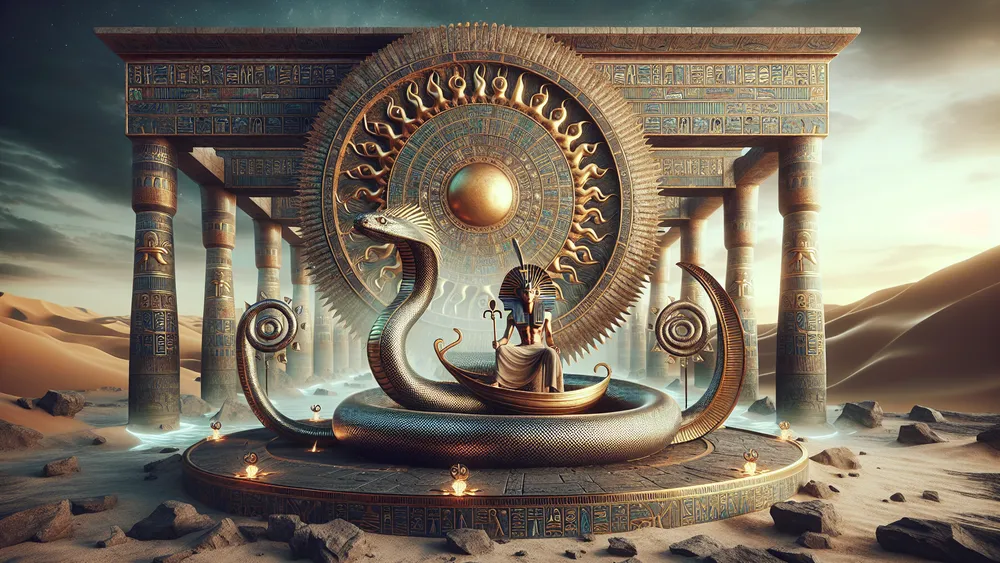
For example, in Pyramid Texts and the Book of the Dead, Mehen is often mentioned and shown, highlighting his role in the trip through the underworld. Items like amulets and carvings also have Mehen, usually showing his coiling shape and guarding nature. These images help us see what Mehen symbolizes as a guardian and a sign of forever, emphasizing his key role in old Egyptian stories.
Mehen symbolizes protection and order in ancient Egyptian stories, often represented as a coiled snake guarding the universe.
The Cult and Worship of Mehen
Having looked at how Mehen is shown and what he means, let’s dive into how people in old Egypt honored and worshipped him.
How the Middle Kingdom Boosted Mehen’s Followers
Picture the rising fame of a current person, where more people follow and celebrate them. Similarly, the Middle Kingdom saw more people joining Mehen’s followers. This time, known for its religious and cultural rebirth, placed more focus on the protective spirits of the underworld. Mehen, being a guard for Ra and Osiris, became a main worship figure.
Rituals for Mehen had offerings, prayers, and making amulets with his image. Such acts were believed to call his protection and ensure safe passage through the next life, showing how much they believed in Mehen’s strength and role.
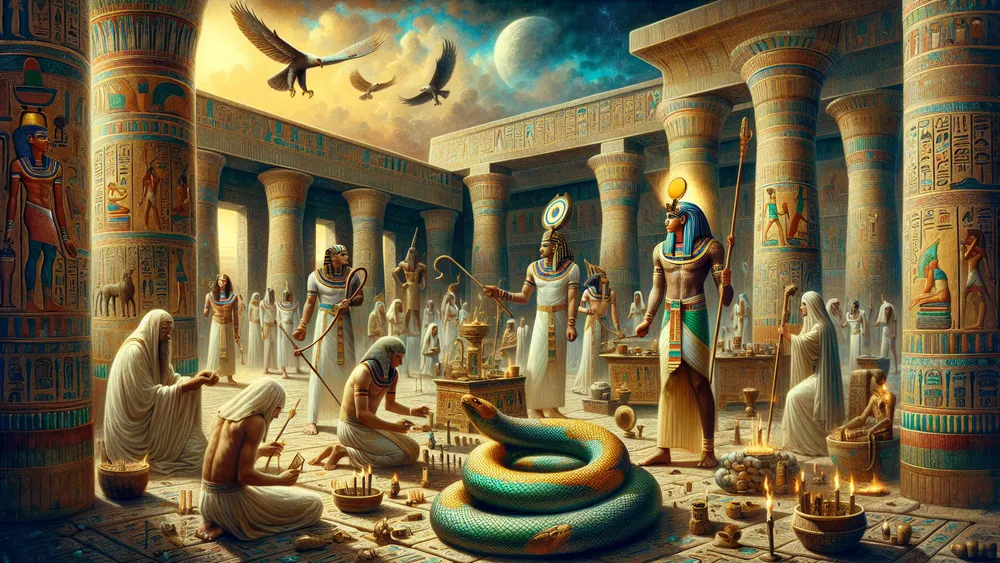
Rituals and Ceremonies for Mehen
Think about going to a current religious service where certain rituals are performed to honor a god. In the same way, old Egyptians had many rituals and ceremonies to ask for Mehen’s protection and favor. Offered items could be food, incense, and snake-shaped amulets, believed to hold Mehen’s protective strength.
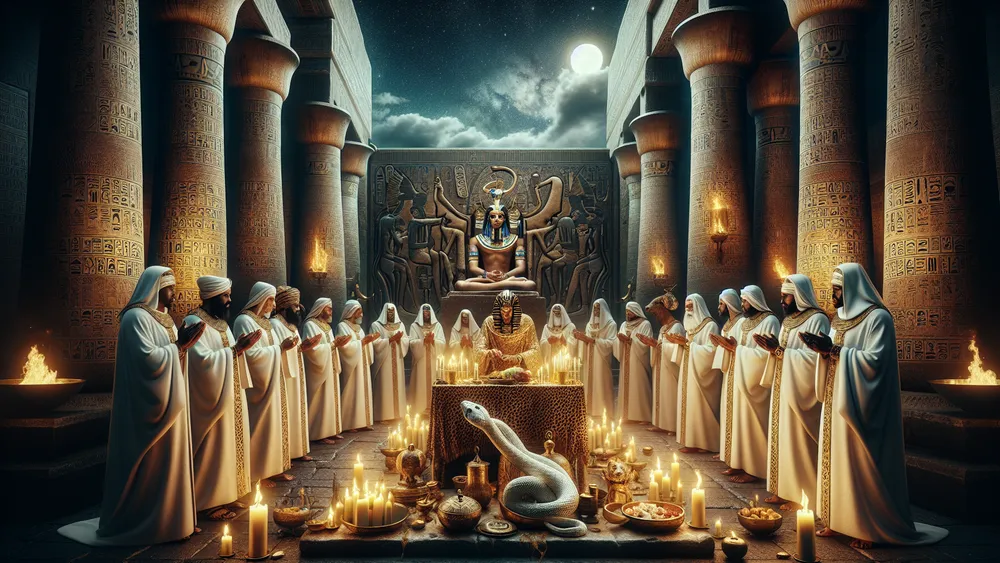
Priests would say hymns and prayers for Mehen, mostly at night to match his role in guarding Ra during the sun god’s nightly trip through the underworld. These acts weren’t just for worship but were also key in making sure the deceased were safe and well on their journey through the next life, which shows Mehen’s crucial place in ancient Egyptian spiritual life.
Mehen in the Books of the Underworld
Visualize ‘The Books of the Underworld’ as old guides that map out the tough trip through the afterlife. In these texts, Mehen shown as a watchful guard, wrapping around the solar barque to shield Ra from the chaotic forces that could hurt him during his nightly journey. These books, like the Amduat and the Book of Gates, describe what Mehen does in much detail, stressing his protective role.
For example, in the Amduat, Mehen wraps around the sun god’s boat, showing his job in keeping the divine order safe from chaos. Such descriptions underline how important Mehen is, not only for the gods’ safe journey but also for souls passing through the underworld, making clear his status as a major protector in ancient Egyptian stories.
Mehen’s Legacy in Ancient Games
Now that we’ve looked at Mehen’s part in stories and worship, let us focus on his interesting mark in old Egyptian games.
Mehen: The Ancient Board Game
Think about playing a game like Snakes and Ladders, yet with deep myth meaning, an old Egyptian game named after Mehen, the twisting serpent god, was a round game with a curving track like a snake. Players with lion-shaped pieces moved through this spiral, trying to get to the middle then go back outside.
Although not fully clear, the rules seemed to mix strategy and chance, similar to today’s board games. This game was more than just fun; it had religious meaning, showing the travel through the underworld and Mehen’s protective hold.
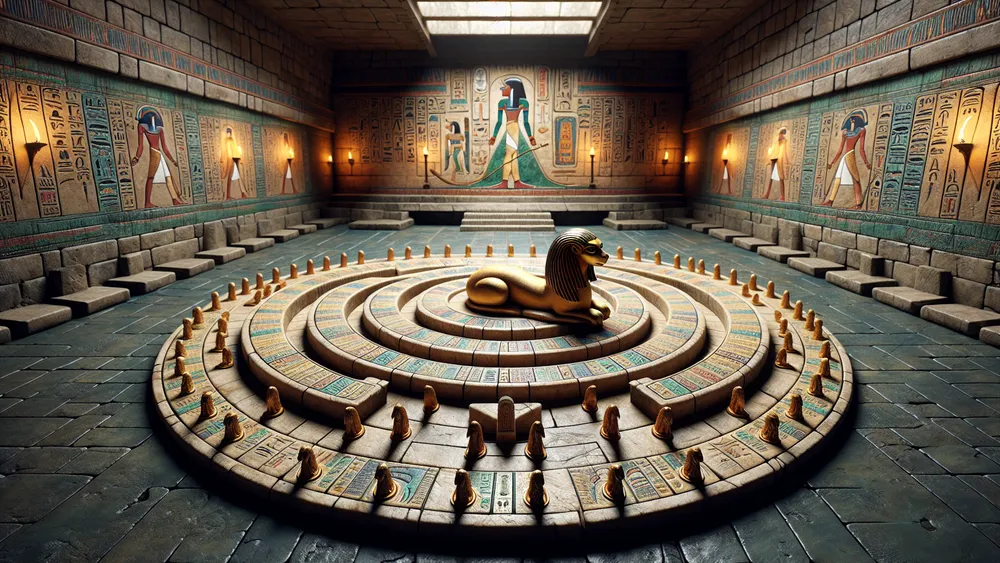
Found in tombs and old art, the game of Mehen shows how daily life and spiritual beliefs were connected in ancient Egypt, giving a captivating look into their culture and values.
The Game and the God: What It All Means
Think about how modern games often show cultural stories or beliefs, like how chess stands for strategic war. In the same way, the old board game of Mehen is closely tied with the traits of the god Mehen.
The twisting shape of the game board looks like the curling snake, standing for protection and the idea of life and death going in circles. Just as Mehen winds around and guards Ra during his night trip through the underworld, the game pieces move through the spiral, showing the trip of the soul and the protective hold of the god.
This symbolic link shows the old Egyptians’ belief in Mehen’s protective strength, both in their spiritual acts and in their daily lives, as they tried to reflect the god’s traits through playing.
Which Came First: God or Game?
Think about the common “chicken or the egg” problem when wondering if the game of Mehen influenced the god or the other way around. Experts don’t agree on this, with some saying the game, with its winding snake shape, came before the god and shaped the idea of Mehen as a guarding snake god.

They show proof of the game played in the Early Dynastic Period, which points to its symbols being added to belief stories later. Other experts, however, think that the god Mehen was there first, and the game was made to show his guarding traits, acting as a ritual example of his role in keeping the sun god Ra safe.
This view is backed by how Mehen is included in belief writings and images that stress his divine guarding role. The argument is still open, but it shows the close link between cultural ways and belief systems in ancient Egypt.
Pantheon of Egyptian Mythology Gods
Think of a big, detailed family where each person has their own job and story. The pantheon of Egyptian mythology is like that, including many gods and goddesses, each with unique traits and roles.
From well-known gods like Ra, the sun god, and Osiris, the god of the afterlife, to less-known ones, the Egyptian pantheon shows the rich and detailed belief system of old Egypt. For a full list of all the Egyptian gods, you can check out this detailed source that looks into the many gods worshipped all through Egypt’s past.
This big list gives a look into the different and interesting world of Egyptian mythology, giving a deeper idea of how these gods influenced all parts of old Egyptian life.
FAQs
1. What roles did Mehen play in ancient Egyptian mythology?
The roles Mehen played in ancient Egyptian mythology include being a guardian of Ra during his nightly journey through the underworld and protecting Osiris and assisting in the journey of souls.
2. How is Mehen depicted in ancient Egyptian art?
Mehen is depicted in ancient Egyptian art as a giant coiling serpent, often shown encircling the solar barque or protecting deities like Ra and Osiris.
3. What is the significance of the nine rings of Mehen?
The significance of the nine rings of Mehen lies in their representation of protection and the cyclical nature of the cosmos in ancient Egyptian mythology.
4. How did the ancient game of Mehen reflect the deity’s attributes?
The ancient game of Mehen reflected the deity’s attributes by symbolizing protection and the cyclical nature of life, much like the coiling serpent guarding the sun god Ra.

